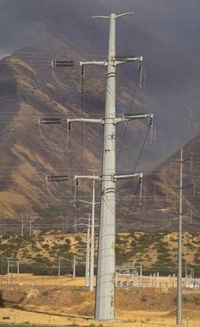Transmission & Distribution

There are significant upgrades and expansions necessary throughout the transmission and distribution system to move the energy from the power plant to the consumer. The power sent from a generation facility is converted at substations and downgraded and dispersed to individual homes along the transmission and distribution lines.
The existing transmission and distribution grid in North America was not built to handle the current capacity. As power demands grow, new transmission and distribution improvements will be paramount to avoid bottlenecks due to the existing constraints.

Transmission
Transmission lines are like the interstate highway of electricity delivery regulated by the Federal Energy Regulatory Commission (FERC). Transmission moves power from sources of generation to the distribution grid. Investment in transmission infrastructure has increased significantly in the past several years, growing from $15.6 billion in 2012 to $21.9 billion in 2017. The majority of this investment is to upgrade and replace aging infrastructure as well as increase the reliability, security and resilience to minimize catastrophic events. Furthermore, as renewables (solar and wind) expand, there is new development required to link the generation to consumers.
There are 600,000 miles of transmission lines in the US, 240,000 miles of which are more than or equal to 230-kV. Many structures are past a 50-year life expectancy and some reach nearly a century. A 2015 DOE report found that 70% of transformers and transmission lines are 25 years or older.

Distribution
Once power is generated and transmitted over long distances to substations, it is stepped-down and distributed to residential, commercial, and industrial consumers. Distribution is the “last mile” of the delivery system of electricity, typically regulated by states. Distribution is a key failure point in the grid as far as reliability, accounting for 92% of electric service interruptions.
When distribution lines were first being built more than 50 years ago, wooden poles were primarily used and placed directly in the soil to bring power to every demand point. At the time, wooden poles were plentiful and inexpensive; however, over time the market has transitioned to using steel poles when new lines are created or old poles are replaced. Galvanized steel poles have made inroads in the marketplace, because they provide a variety of advantages over wood poles and are less expensive than in-ground placement of cables.
There are approximately 5.5 million miles of local distribution lines in the US. The investment in distribution systems has risen 54% in the past two decades from $31 billion to $54 billion annually. This investment is to upgrade aging infrastructure and incorporating resiliency to withstand extreme weather events. There is also a need to connect more renewable generation to the grid. Since Superstorm Sandy (2012), electric companies have invested more than $285 billion in transmission and distribution to harden the grid for future storms.
Visit HERE to Learn about the Steel Utility Pole Coalition.